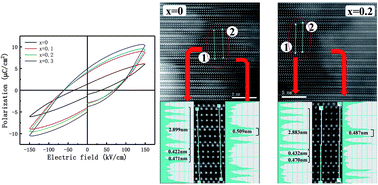Multiferroic complex oxides with intergrowth aurivillius phases are gaining more and more attention due to the potential to greatly adjust their ferroelectricity (FE) and ferromagnetism (FM) using non-integer layer numbers. In this work, the 2 + 3 aurivillius intergrowth phases of Bi7Ti4−2xCoxNb1+xO21 were successfully synthesized via a solid reaction method. X-ray diffraction (XRD) and high angle annular dark field scanning transmission electron microscopy (HAADF-STEM) analyses clearly demonstrated that Co substituted Bi7Ti4−2xCoxNb1+xO21 keeps an intergrowth phase structure when x ≤ 0.3. A new analysis method that maps the linear brightness in HAADF images was used to give the clear Bi atom position, and this revealed that the lattice shrinkage in the c direction caused by Co substitution mainly occurred at the (BiTiNbO7)2− block in the (Bi3TiNbO9) layer, which was also confirmed by an investigation using Raman spectroscopy. Polarization–electric field (P–E) investigations and pulsed polarization positive-up negative-down (PUND) measurements indicated that Bi7Ti4−2xCoxNb1+xO21 (x = 0.1, 0.2, and 0.3) presents much enhanced properties compared with non-substituted Bi7Ti4NbO21. For example, 2Ec = 135.23 kV cm−1 and 2Pr = 9.33 μC cm−2 can be achieved when x = 0.3. Also with Co substitution, Bi7Ti4NbO21 changed from diamagnetic (χ < 0) to paramagnetic (χ ≈ 7 × 10−5). The calculated effective magnetic moments in the Bi7Ti4−2xCoxNb1+xO21 samples have similar values, suggesting that the cobalt atoms in the materials have almost the same efficient moment.

